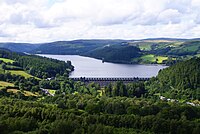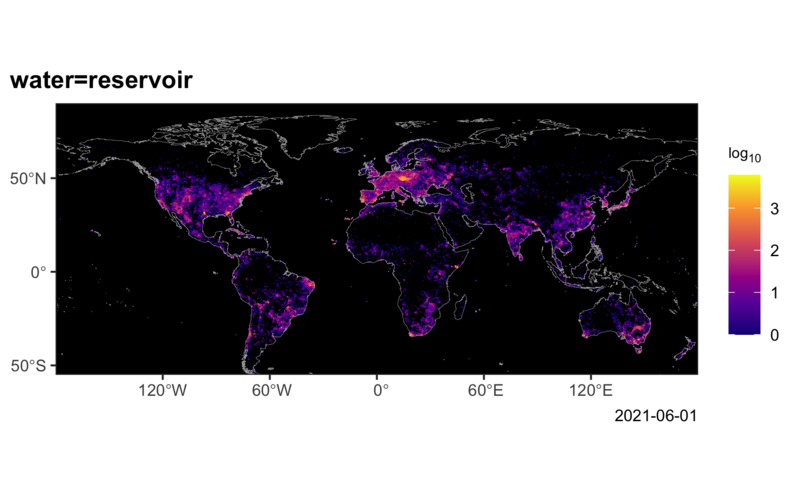Tag:water=reservoir
 |
| Description |
|---|
| An artificial lake which may be used to store water. Usually formed by a dam over a natural water course. |
| Group: water management |
| Used on these elements |
| Requires |
| Useful combination |
| See also |
| Status: approved |
| Tools for this tag |
A reservoir is, most commonly, an enlarged natural or artificial lake, pond, or impoundment, created using a dam to store water (reservoir on Wikipedia). While not as common, a reservoir need not be dammed by a dam. Some reservoirs are created from ordinary lakes by adding a drainage tunnel.
See also water=pond for very small artificial ponds and water=basin for an area of land artificially graded to hold water, and man_made=reservoir_covered for an underground or covered water reservoir.
How to map
Draw the reservoir ![]() outline on the shoreline. For intermittent reservoirs (which are sometimes dry), draw an outline around the visible high water mark, and tag it with
outline on the shoreline. For intermittent reservoirs (which are sometimes dry), draw an outline around the visible high water mark, and tag it with intermittent=yes.
Add natural=water and water=reservoir.
For the dam waterway=dam is used.
Tags used in combination
name=*- The primary name: in general, the most prominent signposted name or the most common name in the local language(s)seasonal=*- Describes features that depend on seasonal conditionsintermittent=yes- Used to indicate whether or not a waterway or water body does not permanently contain waterswimming=*- Whether swimming is allowed at specific location
Types of reservoirs
Reservoirs include the following types:
- Dammed valleys rely on the natural topography to provide most of the body of the reservoir. A dam is typically located at a narrow part of a valley downstream of a natural basin. Sometimes additional side dams are required to contain the reservoir. In hilly regions, reservoirs may be constructed by enlarging existing lakes.
- Coastal reservoirs are fresh water storage reservoirs located on the sea coast near the river mouth to store the flood water of a river. Many coastal reservoirs were constructed in Asia and Europe.
- Bank-side reservoirs, where water is pumped or siphoned from a river to store the water. Such reservoirs are usually formed partly by excavation and sometimes by building an encircling levee on Wikipedia or embankment: in OpenStreetMap these are tagged was
water=basinorlanduse=basin. - Service reservoirs are used for storage of potable drinking water close to the point of distribution. While these are called "reservoirs" in water systems jargon, these are usually not open bodies of water, but rather a storage tank, cistern, basin or a water tower, and thus should be tagged instead as
man_made=storage_tank,water=basin/landuse=basin,man_made=reservoir_coveredorman_made=water_toweras appropriate.
Usages
Reservoirs are used for multiple purposes:
- Water supply. Many reservoirs are used to provide the raw water feed to a water treatment plant which delivers drinking water through water mains, or irrigation water used by agriculture.
- Hydroelectricity. A reservoir generating hydroelectricity includes turbines connected to the retained water body by large-diameter pipes. These generating sets may be at the base of the dam or some distance away.
- Controlling watersources. Reservoirs can be used to control water flow in downstream waterways:
- Water may be released from an upland reservoir so that it can be used downstream for drinking, irrigation, etc.
- Flood control and flow balancing reservoirs collect water at times of high flow, then release it slowly during the following weeks or months.
- Water may be released from a reservoir to supplement white water conditions for white-water sports, or to encourage natural migration behaviours in fish
- Recreation. Many reservoirs often allow some recreational uses, such as fishing and boating.
Examples
Dammed valleys
- Lake Mead
 Lake Mead, a dammed valley and the largest reservoir in the United States.
Lake Mead, a dammed valley and the largest reservoir in the United States. - Lake Kariba
 Lake Kariba, formed by damming the Zambezi Valley at the Kariba Gorge to generate power and to form the world's largest man-made lake and reservoir by volume.
Lake Kariba, formed by damming the Zambezi Valley at the Kariba Gorge to generate power and to form the world's largest man-made lake and reservoir by volume. - Llyn Clywedog
 Llyn Clywedog in Wales, a dammed valley in which additional side dams are required to contain the reservoir.
Llyn Clywedog in Wales, a dammed valley in which additional side dams are required to contain the reservoir. - Llwyn-on
 Llwyn-on, Cantref
Llwyn-on, Cantref Cantref and Beacons Reservoirs
Cantref and Beacons Reservoirs Beacons Reservoirs are examples of a chain of reservoirs in the
Beacons Reservoirs are examples of a chain of reservoirs in the  River Taff valley.
River Taff valley.
Coastal reservoirs
- Marina Barrage
 Marina Barrage in Singapore
Marina Barrage in Singapore - Qingcaosha
 Qingcaosha in China
Qingcaosha in China - Plover Cove
 Plover Cove in Hong Kong
Plover Cove in Hong Kong
Bank-side reservoirs
- Queen Mary Reservoir
 Queen Mary Reservoir in the United Kingdom
Queen Mary Reservoir in the United Kingdom
Flood control reservoirs
- Lake Burrendong
 Lake Burrendong in Australia
Lake Burrendong in Australia - Bala Lake (Llyn Tegid)
 Bala Lake (Llyn Tegid) in North Wales
Bala Lake (Llyn Tegid) in North Wales
Dam-less reservoirs
- Ljosavatnet
 Ljosavatnet in Norway, is a reservoir without a dam. Regulation is achieved solely by a drainage tunnel having been mined into the bottom of what was once a lake. The riverbed of what used to be the river leading out of the lake now serves as a spillway.
Ljosavatnet in Norway, is a reservoir without a dam. Regulation is achieved solely by a drainage tunnel having been mined into the bottom of what was once a lake. The riverbed of what used to be the river leading out of the lake now serves as a spillway.
Retired or disused reservoirs
Reservoirs may be retired or otherwise stop being in regular use. Below are some recommended strategies for retagging.
- The reservoir structures still exist, and the reservoir may be filled with water once or more per year: Add
intermittent=yes, and map the area of the high-water mark. - The reservoir structures are no longer intact, but the depression in the ground still results in a wetland: map the
natural=wetlandand add the appropriate value ofwetland=*. The previous area of the reservoir can be taggedabandoned:water=reservoir. - The reservoir structures are gone and there are no remaining features visible: Delete the reservoir. Or if there is inconsistency in the imagery sources that could lead to mapper confusion, leave area in place with
abandoned:water=reservoir.
In all above cases, leaving the name=* is a matter for local judgement. In some cases the old name is no longer relevant, but in other cases locals still refer to the property by the original name, making it appropriate to tag.
Tagging elevation
Since reservoirs have water levels that vary significantly, it can be hard to interpret what is implied by an ele=* value.
In Norway, there is some precedence for using the following scheme to clarify the exact meaning of elevations:
ele:min=*for the lowest water level achievable by regulation.ele:max=*for the highest water level achievable by regulation.ele:natural=*for the elevation a potential lake would have without regulating structures.
Mapping partial intermittency
A common base practice for mapping a reservoir, is mapping the outline of the maximum water level. Since many reservoirs seldom achieve this level in practice, there is a desire to map part of the area of a reservoir as being intermittent. This usually applies to the area difference between the reservoir in its minimum water level state and its maximum water level state.
There is no clear, established practice for how to do this, but some examples exist:
- Lake Mead
 Lake Mead is not tagged as intermittent, but is surrounded by another lake Lake Mead full-water area
Lake Mead is not tagged as intermittent, but is surrounded by another lake Lake Mead full-water area Lake Mead full-water area that is intermittent.
Lake Mead full-water area that is intermittent.
- Ljosavatnet
 Ljosavatnet is mapped with an outer way at the maximum water level. Inside the reservoir, there are additional small lakes, at layer=-1, that represent the minimum water level. The reservoir is tagged as intermittent.
Ljosavatnet is mapped with an outer way at the maximum water level. Inside the reservoir, there are additional small lakes, at layer=-1, that represent the minimum water level. The reservoir is tagged as intermittent.
Objects frequently associated with reservoirs
- Dam - A barrier built across a river or stream to impound the water.
- Intake tower - a vertical tubular structure with one or more openings used for capturing water from reservoirs. Tower with Tag:tower:type=intake.
Tagged objects distribution
Possible tagging mistakes
See also
water=lake+natural=water- For a lakewater=pond+natural=water- For a pondman_made=reservoir_covered- a covered reservoir is a large man-made tank for holding fresh waterlanduse=basin- an area of land artificially graded to hold water. Also tagged withwater=basin.man_made=storage_tank+content=water- a container that holds waterman_made=water_tower- a structure with a water tank at an altitude to increase pressure in water networkemergency=water_tank- a large water basin or tank for a fire department to take water
